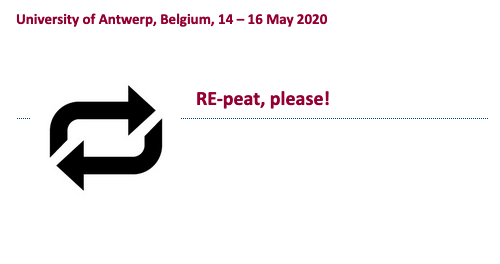Update 17.3.2020: Aufgrund der Einschränkungen im öffentlichen Leben und dem akademischen Betrieb wegen der Corona-CoVid19-Pandemie wurde die Tagung auf Oktober 2020 verschoben. Ich halte das (zum heutigen Stichtag) für eine sinnvolle Maßnahme, da es in dieser Phase hauptsächlich darum, durch Kontaktreduktion die Verbreitung des Virus zu bremsen: #flattenthecurve und #socialdistancing Die Veranstalter haben meine volle Unterstützung für diese Verschiebung. Hoffentlich ist bis dahin die Situatioin wieder unter Kontrolle und das Leben kann sich wieder normalisieren.
Ich darf bei der Tagung „RE-peat, please!“ der Kolleg*innen von der IASPM Benelux einen Vortrag halten. Das genaue Programm steht noch nicht fest, aber allgemeine Infos (der Call und die beiden Keynote-Speaker) finden sich auf der Website der Konferenz.
Bei diesem Vortrag steht die Wiederholung von EDM im Zentrum, und ich werde v.a. darauf eingehen, wie diese sowohl den DJs bei der Produktion (Poiesis) des DJ-Sets als auch den Rezipient*innen bei der Wahrnehmung (Aisthesis) des DJ-Sets produktiv entgegenkommt und lusterzeugend wirken kann.
Das Forschungsfeld der musikalischen Repetition wird in letzter Zeit (wieder) häufig thematisiert: insbesondere der Sammelband „Over and Over“ (Julien/Levaux, Bloomsbury 2018) und die Tagung „Again and Again“ (London, 25.-26. April 2019), bei der ich auch einen Vortrag halten durfte, sind hier zu nennen – neben den schon etwas älteren, aber deswegen nicht minder relevanten Büchern von Robert Fink: „Repeating Ourselves“ (UoC Press 2005) und von Anne Danielsen: „Presence and Pleasure“ (Wesleyan UP 2006).
Ich greife für den Vortrag auf Teile aus meinem Vortrag in London zurück, werde ihn aber natürlich mit aktuellen Gedanken und Erkenntnissen anreichern. Hier mein Abstract:
RE-peat and RE-construct. On the making and the pleasure of repetition in EDM DJ sets
Repetition is an important aesthetic feature of popular dance music genres – from funk through disco to current genres of electronic dance music (EDM). Though acknowledging its importance, many authors have placed a greater emphasis on its ‘significant other’ – variation. While funk-musicians continuously ‘shape’ their grooves (Danielsen 2006), electronic music production allows for exact repetition. Such an emphasis makes repetition in EDM “not only […] a fundamental structural principle but also […] a deliberate aesthetic strategy” (Butler 2014: 187). This raises multiple questions: What makes repetition such an important feature of EDM? What psychological and aesthetic mechanisms are at work, that translate musical repetition in bodily and emotional, corporeal and affective pleasure? The first part of my presentation deals with these questions from a media-musicological and psychological perspective.
During the second part of my talk I will focus on the DJ and his/her approaches to repetition. DJs remain an important type of performing artist in EDM, although for a number of years the importance of laptop performers has increasingly blurred the lines between the two. One important difference worth noting is that, while laptop performers mostly construct their music, relying on repeating grooves and patterns, DJs have to de- and re-construct their musical material. These processes alter the timeflow and formal structure of the musical material used. Taking this context into account, I will suggest a threefold theoretical concept of analysing a DJ set and its poiesis by the DJ considering repetition in relation to other aesthetic principles applied by DJs.
- Butler, Mark J.: Playing with Something that Runs. Technology, Improvisation and Composition in DJ and Laptop Performance; Oxford Univ. Press, New York 2014.
- Danielsen, Anne: Presence and pleasure. The Funk Grooves of James Brown and Parliament; Wesleyan Univ. Press: Middletown, Conn. 2006.
